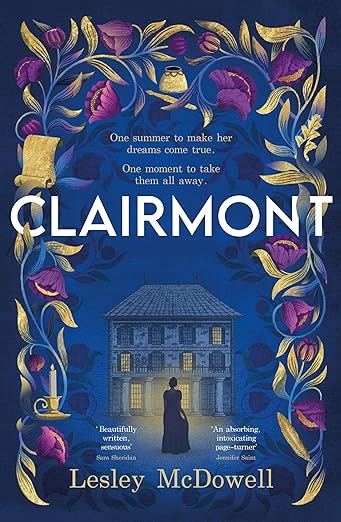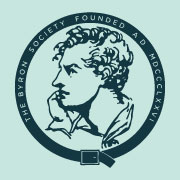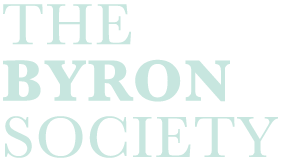
CLAIRMONT by Lesley McDowell
Claire Clairmont – the incredible woman that history tried to forget.
But in the year that will mark the 200th year anniversary of Lord Byron’s death, Claire will finally find her voice and tell her side of the story of that fateful Geneva trip.
A massive volcanic eruption has caused the worst storms that Europe has seen in decades, yet Percy Shelley and Mary Godwin have chosen to visit the infamous Lord Byron at his villa on Lake Geneva. It wasn’t their idea: Mary’s eighteen-year-old stepsister Claire Clairmont, insisted.
Gordon Ferries, Stanzas for Music
Presenting a brand new music book by Edinburgh based guitarist, composer and Byron society member Gordon Ferries,. ‘Stanzas for music’ (published by Bergman editions) features four songs for voice and classical guitar to poems by Coleridge, Shelley, Keats and Byron. The featured poems all address the transcience of time and nature. The Coleridge text is the section of ‘Christabel’ that Byron used as an epigraph for ‘Fare thee well, his poem about his disasterous marriage to Anabella Millbanke and his imminent exile to the continent. Byron also famously read from Coleridge’s vampiric’ Christabel’ during the notorious ghost story sessions at the Villa Diodati in 1816, where both Mary Shelley’s Frankenstein and Polidori’s’The Vampyre’ were both concieved. The collection also contains settings of Shelley’s ‘Mutability’ Byron’s ‘There’s not a joy the world can give’ (Stanzas for music) and a section of Keats’ ‘Sonnet, on the sea’ The songs can be sung by soprano or tenor.
Graham Davidson, The Intelligible Ode: Intimations of Paradise
In this monograph, Graham Davidson traces the origins of Wordsworth’s poetic impetus to his resistance to the Cartesian division between mind and nature, first adumbrated by the Cambridge Platonists. If reunited, Paradise was regained, but this personal trajectory was tempered by a deep sympathy for the woes of mortal life. Davidson explores the consequent dialogue through some of Wordsworth’s best-known poems, at the heart of which is the Ode. In the last section, he demonstrates how Wordsworth’s publishing history led the Victorians and modernists to misinterpret his work; if one considers Eliot’s Four Quartets as odes, facing several of the same problems as did Wordsworth, there is some irony in Eliot’s dismissal of the Immortality Ode as ‘verbiage’.
Book details and purchase here.
Ioannes P. Chountis. Romanticism in Power. Aspects of Lord Byron’s Political Ideology and His Participation to the Greek War of Independence. Athens: Armos Publications, 2022 (in Greek)
This book examines the political views of Lord Byron and his participation to the Greek Revolution of 1821. Particular emphasis is placed not on Byron’s much-analyzed poetry, but on the rather neglected and underappreciated subject of his opinions on various political issues, ranging from the revolutions in continental Europe, social reforms in Regency Britain, to his views on the ideal constitution. Furthermore, through the close reading of his correspondence, his critical and decisive role in the Greek Revolution as well as his disappointments are highlighted. Shortly after the bicentennial of the Greek Revolution of 1821 and before the completion of two hundred years since the death of Lord Byron, this book attempts to highlight the bridges of cooperation and friendship between Greece, Europe, and the United Kingdom.
Reading Byron: Poems – Life – Politics by Bernard Beatty
Bernard Beatty agrees that Don Juan is his greatest poem but argues that the force of Byron cannot be fully registered unless we again attend to and find a way of reading his ‘dark’ poems and take his thought seriously. This book tries to show what such a way might be. This is the heart of the book and it is new but there are some shorter chapter on Byron’s Life and Politics which originated as articles or lectures but have been refashioned for the book.This is a new and timely approach to reading Byron by someone who has devoted much of his life to reading, writing, and thinking about him.
More details and purchase here
An Impossible Interview with Lord Byron (Intervista impossibile a Lord Byron) by Vincenzo Patane
An Impossible Interview with Lord Byron (Intervista impossibile a Lord Byron) was conceived in the wake of a well-known Italian radio programme. The programme – entitled “The Impossible Interviews” – was broadcast on the second RAI radio channel in 1974 and 1975, for a total of 82 episodes. In each of them, a prominent intellectual interviewed a great person from the past, who lived over a period of time ranging from prehistory to the twentieth century.
The Complete Poetry of Percy Bysshe Shelley, Vol. 7, Edited by Nora Crook
Blasphemy and sedition laws prevented her from including her husband’s most outspoken radical works, but the resulting volume, Posthumous Poems of Percy Bysshe Shelley (1824), was a magnificent display of Shelley’s versatility and craftsmanship between 1816 and 1822. Few such volumes have made more difference to an author’s reputation.
The seventh volume of the acclaimed Complete Poetry of Percy Bysshe Shelley extracts from Posthumous Poems those original poems and fragments that Mary Shelley edited. The collection opens with Shelley’s enigmatic dream vision The Triumph of Life, the last major poem he began—and, in the opinion of T. S. Eliot, the finest thing he ever wrote. There follow some of the most famous and beautiful of Shelley’s short lyrics, narrative fragments, two unfinished plays, and other previously unreleased pieces.
More details and purchase here
Shelley’s Broken World: Fractured Materiality and Intermitted Song by Bysshe Inigo Coffey
Shelley’s prosody grew to articulate his sense that actuality is experienced as ruptured and fractured with gaps and limit-points.He shows us the weakness of the actual. As we approach the bicentenary of the poet’s death, Shelley’s Broken World provides an exciting new beginning for the study of a major Romantic poet, the history of materialism, and prosody.
More details and purchase book here.
Dangerous to Show: Byron and his Portraits, by Geoffrey Bond and Christine Kenyon Jones
This book explores Byron’s life through the intriguing stories behind these images, and for the first time reveals in colour the key paintings, miniatures, sculptures, drawings and sketches, as well as prints, cartoons, engravings and Byron memorabilia. It uses Byron’s own forthright and witty words to recount his responses to ‘Byromania’ and his attempts to manage his own image through the way he was presented in his portraits, as well as through fashion, weight control and the disguise of his lameness.
You do not have to be a Byromaniac to enjoy this sparkling survey of his Lordship’s wildly shifting iconography through two centuries of celebrity and notoriety. The fantastic transformation of Byron’s image, from solemn portraiture to souvenir pottery, from memorabilia to merchandising, from marble to mockery, from miniatures to movies (I could go on) is constantly surprising and instructive. It’s also a great deal of fun, a brilliant revelation of poetic fashions and fandom. The authors successfully combine scholarship with mischief, and throw fresh light on the enduring provocations of Byron’s poetry and personality, not least the astonishing fact that he was not admitted to Poets’ Corner, Westminster Abbey until 1969. (Richard Holmes)
The Virtues of Scandal by Richard Abramson
As the waters of scandal rise, and Byron becomes the unwitting pawn in a vast conspiracy that reaches to the highest levels of government, England’s most famous and incandescent poet must decide for what – and for whom – he is prepared to make a terrible sacrifice.
Set in Seville, London, Constantinople, Ottoman Greece and St. Petersburg during the first decades of the 19th century, The Virtues of Scandal is a thrilling tale of conspiracy, scandal, betrayal and courage. Interlacing three narratives that span more than a decade and include the rousing adventures of Don Juan himself, the novel is rich with historical detail, bringing to life the gifts, flaws and contradictions that number Byron among the greatest of poets and the most confounding of men.
For more details and to purchase the book, click here.
The Fall of the House of Byron: Scandal and Seduction in Eighteenth-Century England by Emily Brand
This was the home that a small, pudgy boy of ten from Aberdeen – who the world would later come to know as Lord Byron, the Romantic poet, soldier, and adventurer – would inherit in 1798. His family, he would come to learn, had in recent decades become known for almost unfathomable levels of scandal and impropriety, from elopement, murder, and kidnapping to adultery, coercion, and thrilling near-death naval experiences. Just as it had shocked the society of Georgian London, the story of the Byrons, and the folklore of their outlandish scandal, would influence his life and poetry for posterity.
The Fall of the House of Byron follows the fates of Lord Byron’s ancestors over three generations in a drama that begins in rural Nottinghamshire and plays out in the gentlemen’s clubs of Georgian London, amid tempests on far-flung seas, and in the glamour of pre-revolutionary France. A compelling story of a prominent and controversial characters, it is a sumptuous family portrait and an electrifying work of social history
For more details and to purchase the book click here.
Byron: Reality, Fiction and Madness eds. Miroslawa Modrzewska and Maria Fengler
This book explores the amorphous, fragmented and digressive world of George Gordon Byron’s poetic works, which are pervaded by the themes of change, mutability, deformation and transgression, often presented or described as madness. The blurring of the border between fiction and reality is a matter of the author’s decisions concerning both his life and his texts, and a conscious process of construction and self-fashioning. It is also a recurring epistemolog¬ical theme in Byron’s works, which takes the form of narrative dis-orientation and the dismantling of easy cultural pre-conceptions. The Authors study Byron’s artistic quixotism and his pursuit of creative freedom, which reveals itself in the Romantic irony, digressiveness and self-awareness of his writings.
More details and purchase options here.
The Imprisoned Traveller: Joseph Forsyth and Napoleon’s Italy, by Keith Crook
Keith Crook, in this authoritative study, evokes the peculiar miseries that Forsyth endured in French prisons, reveals the significance of Forsyth’s encounters with scientists, poets, scholars, and ordinary Italians, and analyzes his judgments on Italian artworks. He uncovers how Forsyth’s allusiveness functions as a method of covert protest against Napoleon and reproduces the hitherto unpublished correspondence between the imprisoned Forsyth and his brother.
The book can be purchased in America here, and will be available in the UK from February here.
A Shadowed Fate by Marty Ambrose
a journey that would allow Claire to lay her tumultuous past to rest. But the valuable Cades sketch given to her by Rossetti is stolen, and Claire soon finds herself shadowed at every turn and in increasing danger as she embarks on her quest.
Is the theft linked to Allegra, and can Claire uncover what really happened in Ravenna so many years ago?
The Sour Fruit. Lord Byron, Love & Sex by Vincenzo Patanè
The book’s original approach provides unusual and fascinating insights, notably into Byron’s homosexuality, hitherto relatively unexplored, and reveals a more truthful picture of the poet. Byron was strongly attracted to boys, who are referred to in Don Juan as ‘sour fruit’. In his adolescence he had fallen for aristocratic contemporaries but would later be attracted to boys of a lower social station. He had several same-sex experiences in England, encouraged by the circle he frequented at Cambridge, particularly his friend Matthews, as well as during his Grand Tour, during which he was able to freely live out behaviours frowned on at home.
An appended chapter examines Don Leon, an anonymous work purporting to be by Byron himself and salaciously recounting his love-life, which was first published some forty years after his death and has been on more than one occasion banned for obscenity.

